8th August 2025
What is a mixed ability class? The simplest definition is “a class with more than one student.” Unless you’re teaching one-to-one, you teach mixed abilities.
Having students at different levels in the same class makes it difficult for everyone to take part. Students who find a class too hard will give up and do something else. Higher level students finish quickly, then have nothing to do. You might start seeing behaviour problems. Students at the top and bottom both make little progress. And that leaves you feeling frustrated.
This is especially true for speaking. When reading and writing, students can take their time. They’re able to pause mid-sentence to look up a word, or ask a classmate. They can go back and edit what they wrote or get feedback on a draft. Speaking doesn’t work like that. In speaking there’s no time to stop, ask for help or edit what you’ve said.
There are a few ways to make speaking tasks work in mixed-ability classes: change the task, offer support, or group students strategically. These all help—but they also take time. And time is something most teachers don’t have.
That’s where AI can help. AI can make it faster to adapt speaking tasks for mixed ability classes. Instead of rewriting activities from scratch, you can use AI to create scaffolds, simplify tasks, or suggest alternatives. Below are nine ready-to-use prompts to help you do that—without adding to your prep time.
Below are practical AI prompts designed to tackle mixed-ability challenges. They’re organised into three areas where AI can make a big difference:
- Supporting different levels
- Preparing for the task
- Adapting the task format
Each has a short explanation and a prompt you can use as-is. Add a screenshot of your coursebook task instead of typing an explanation.
Supporting Different Levels
When you give everyone the same speaking task, you're giving them the same challenge. But their ability to complete it isn't equal. A few well-placed supports can turn frustration into participation.
Think of it like asking everyone to jump over a wall. A few can do it. Most can’t. But if you give some students a step, a ramp, or a running start, they can all get over—just in different ways.
AI helps you create that support quickly. You can generate sentence starters, assign easier roles, show model answers, or create extension tasks. Below are four ways to use AI to support different students on the same speaking task.
Sentence Stems
Some students don’t speak because they don’t know how to start. Giving them the first few words of a sentence can help them get going. AI can write sentence stems that match the exact task students are working on, based on their CEFR levels.
Prompt: My students will do the following speaking task. Some are {CEFR} level. Suggest up to {number} sentence starters or phrases they can use as scaffolding to help them complete a speaking task. {Add speaking task here}
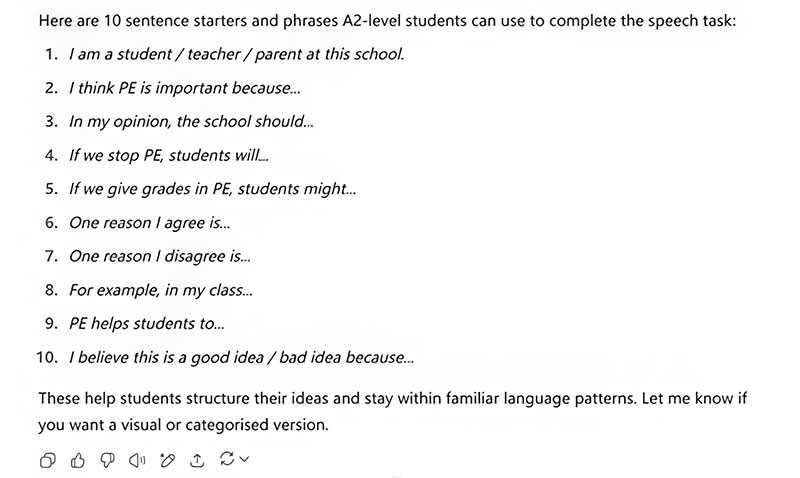
Easy Role / Hard Role
In many speaking tasks—especially role plays—one role is harder than the other. In an interview, for example, reading the questions is easier than answering them in full. In a complaint role play, it’s usually easier to say “I’m sorry” than to explain what went wrong and how you want it fixed.
Sometimes it’s obvious which role is easier. But for more complex tasks, it’s not always clear. That’s where AI can help. Take a screenshot of the task of the role cards, paste it into a prompt, and ask AI which roles are easier or harder, and why.
Prompt: My students will do the following speaking task. Tell me which role is easier or harder and why. Suggest which role I should give to the stronger students in my class and which to the lower-level learners. Explain the reasoning in simple language. {Add speaking task here}

Model Answers
Many students improve just by seeing or hearing how someone else might answer a task. Giving students model answers at different levels lets them compare and notice how responses can change depending on language ability. AI can create these models in seconds.
Prompt: My students are at {CEFR} level. Create three model answers for this speaking task – one at the same level, one above, and one below. {Add speaking task here}
You can also use model answers after a task, letting students compare what they said with the model, and noting the differences.
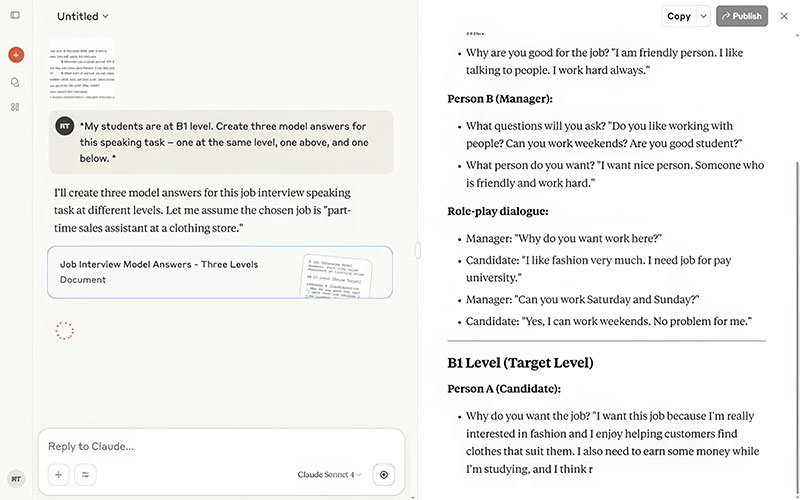
Extension Activities
Imagine you’re a PE teacher. You get all your students to run 5km. Would you expect them all to finish at the same time? Of course not! The fastest runners will stretch, drink water, walk around, chat, and maybe celebrate, while the slower runners are still on the track. That’s fine in PE, but not in a language class. If stronger students finish a speaking task and have nothing to do, they’ll get bored or distract others who are still working. You need something that keeps them learning—and keeps them quiet—while the rest of the class catches up.
AI can suggest some extension activities that relate to your task, keep stronger students on-task, and quiet, when they finish quickly.
Prompt: My students will do the following speaking task from a coursebook. Some are higher-level learners. Suggest 3–5 extension activities they can do while others finish. The activities should not require any extra materials—just what’s already in the book or what students can do on their own. After that, ask me to choose my favourite and create any materials or instructions needed for it. {Add speaking task here}
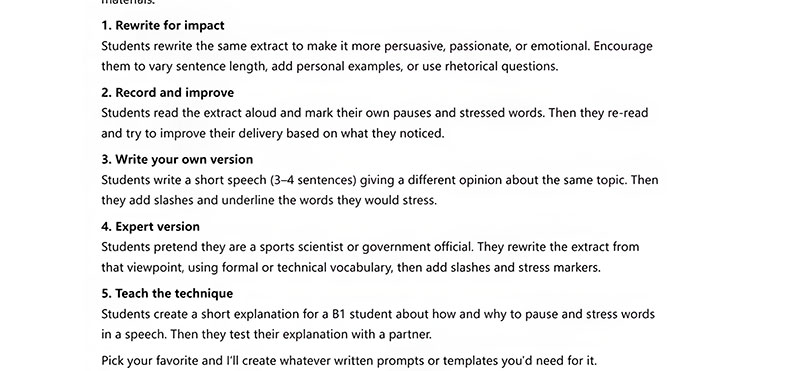
Preparing for the Task
Silence in a speaking class sounds like failure. But it's not.
After years living abroad, I was back in the UK ordering food with friends. As I approached the counter, I caught myself mentally rehearsing my order—then laughed. This was English, my native language. But that habit of practicing in my head what I want to say? I do it whenever I need to say something difficult in Chinese. It makes me feel more confident and speak more fluently.
Silence before speaking isn't empty time—it's preparation. Your students need it too. The problem is, if you just tell them to "take a minute to prepare," some will use it well while others sit there wondering what to start. Structured preparation tasks change that. AI can help you create activities like warm-up questions, vocab support, simplified instructions. Below are four prompts that can help turn silence into speaking.
Preparation for the Task
Real preparation gives students something concrete to do: brainstorm examples, organise ideas, or identify useful language. AI can design these focused prep steps for any speaking task.
Prompt: My students will do the following speaking task from a coursebook. Suggest 3–5 ways to prepare them so they can speak more fluently and accurately during the task. {Insert coursebook task here}
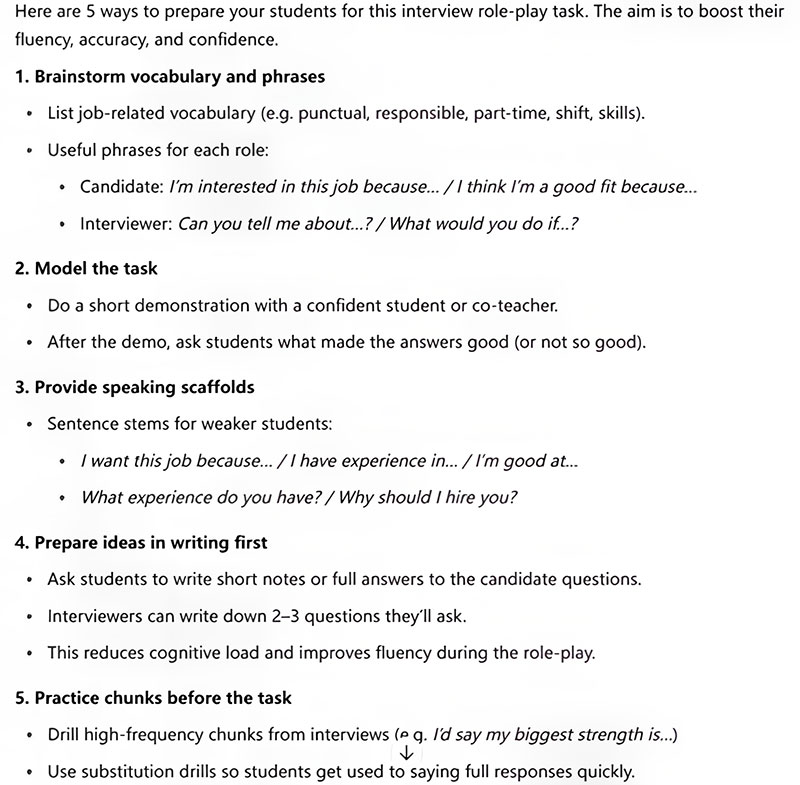
Word Box
Lower-level students often know what they want to say but lack the English words to say it. A word box with key vocabulary in both their first language and English takes away that barrier. AI can create a vocabulary list based on a speaking task and students' level.
Prompt: My students will do the following speaking task from a coursebook. There are some {CEFR} level students in the class. Create a word box with useful vocabulary and translations from their first language into English to help them complete the task. Before doing this, ask me what their first language is. Only include words that are likely to be useful for this specific task. The word box should be ready to give directly to students. {Add coursebook instructions here}
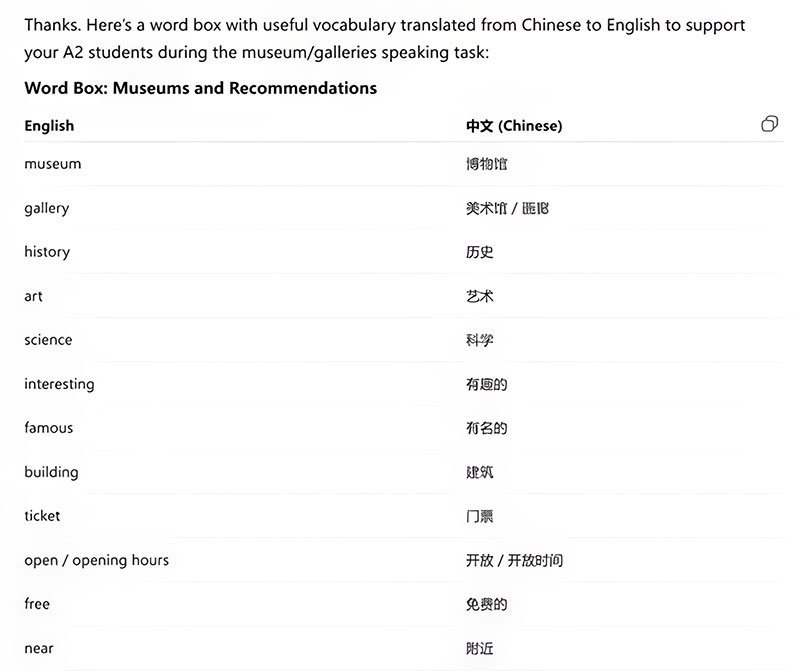
Simpler Instructions
Coursebook instructions are often written at a higher level than the speaking tasks themselves. Your students might be ready for the conversation but can't understand what they're supposed to do. AI can rewrite difficult instructions in simpler language and translate them when needed. Just paste the coursebook instructions along with the prompt below.
Prompt: My students will do the following speaking task from a coursebook. Do the following:
1. Identify the current CEFR level of the instructions.
2. Rewrite the instructions one CEFR level lower, using simpler language.
3. Translate the rewritten instructions into the students’ first language. Before doing step 3, ask me what their first language is. The output should include both the simplified English version and the translation. {Add coursebook instructions here}
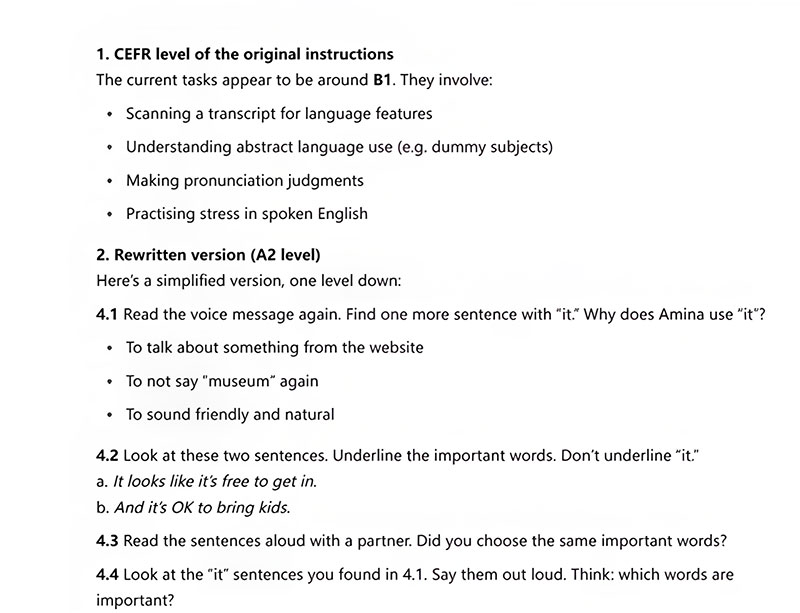
Adapting the Task Format
When I was in secondary school in Scotland, some of my classmates had gone to tiny rural primary schools. A few of those schools had only 20 kids total—across all year groups. So the teachers did what they had to. Students sat in the same classroom but worked on different tasks. The teacher didn’t try to give everyone the same worksheet.
That's an extreme case, but the principle applies to language classes too. You don't need completely different tasks—just different ways of doing the same one. Some students might prefer writing instead of speaking. Some work better alone, others in pairs. These small adaptations can make the difference between participation and silence. Sometimes just having a choice gives students the confidence to speak—because they’re doing it in a way that works for them.
Of course, that means extra planning. What versions of the task will work? How should you group the students? What should reluctant speakers do instead? AI can help with all of that. It can suggest alternative formats, groupings, or even swap a speaking task for a writing one that meets the same goal. Here are three prompts to help you do that quickly.
AI-Alternatives
One way to handle mixed-ability groups is to offer different approaches to the same task. AI can rewrite a task two different ways while keeping the goal the same. You can give your students a choice of which task they want to do. That small bit of control often makes students feel more confident and engaged with the activity.
Prompt: My students will do a speaking task from a coursebook. I have a mixed-ability class. Create two alternative versions of the task that keep the same goal but change how students complete it. First, describe the two alternative versions clearly. Then write student-facing instructions or materials for each one. The alternatives should be ready to use in class. I’ll let students choose between the original task and one of your versions. {Add speaking task here}
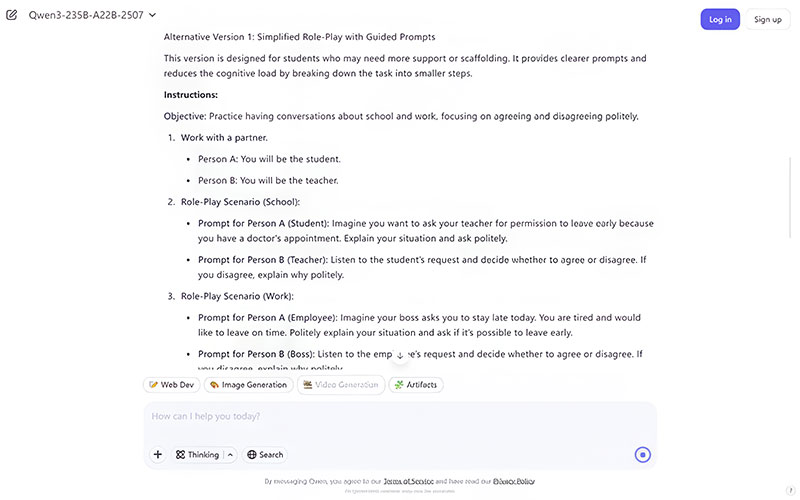
Grouping Guide
How you group students can make or break a speaking task. Should stronger students work together or support weaker ones? Should each student have a different role? AI can help you decide based on the task and give you clear suggestions for grouping and differentiation.
Prompt: I will use the following speaking task with a group of mixed-level students. Suggest how I should group them (e.g., same level vs mixed), and what roles, responsibilities, or support I can give each level so they all participate. {Add speaking task here}

Switch to Writing
Some students just aren't ready to speak in class. Forcing them can do more harm than good. AI can turn speaking tasks into writing alternatives that let reluctant speakers participate without the pressure to talk out loud. They can still practice the same grammar, vocabulary, or language functions through writing.
Prompt: My students will do the following speaking task from a coursebook. Some students are reluctant to speak. Rewrite the task as a writing activity that keeps the same communicative goal. Include an audience (e.g., another student or group) who will read or respond to what they write. Then write simple student-facing instructions for the new version. {Add speaking task here}
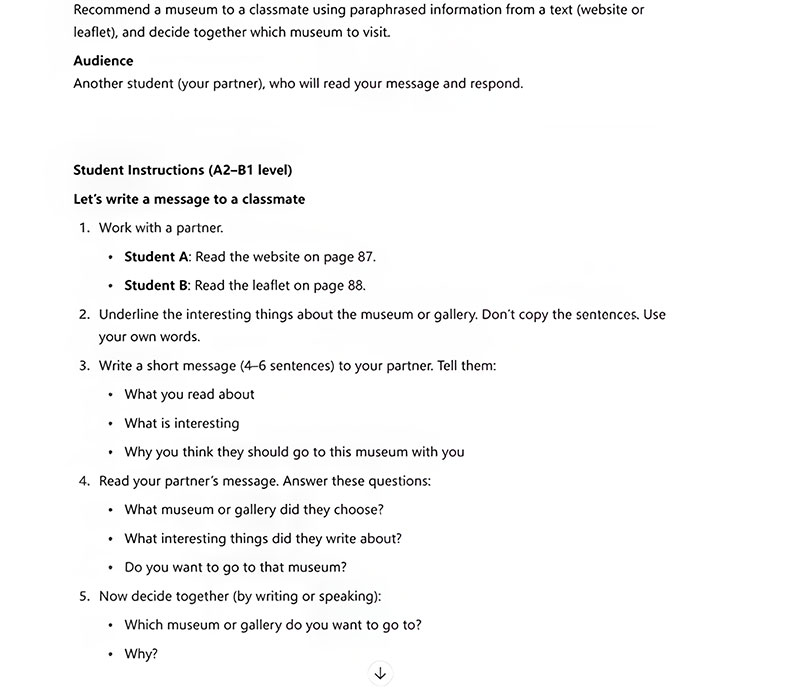
Limitations
AI generates ideas fast, but it doesn't know your students. It can't tell that Stella freezes up with too many choices, or that your afternoon class needs simpler instructions than your morning one. The prompts give you starting points—but you'll need to adapt, reject, or improve what you get.
Be particularly careful to check that any sentence starters are at the right level, translations are correct, and extension activities don't require materials you don't have. I like to get AI to create more materials than I need - maybe 5 sentence starters when I only want 3, or several extension ideas when I'll use just one. This gives me choice and it forces me to read critically and select what will actually work for my students.
You also need to know when not to adapt. Not every student needs sentence starters. Not every fast finisher needs an extension. And some tasks are already clear and effective without changes. AI gives you options—you still choose when and how to use them.
Conclusions
Mixed-ability speaking tasks don't need to be a headache. You don't have to create new lessons or rewrite every activity. With the right prompts, AI can help you tweak what you already have—giving some students a step, others a ramp, but getting everyone over the same wall.
Try one of the prompts in this post. Copy, paste, and adapt it to your own speaking task. Sometimes all it takes is a sentence starter, a role swap, or a moment of preparation to turn silence into participation.
Key Takeaways
- Mixed-ability classes are the norm, not the exception—especially in speaking tasks because students can't pause mid-sentence to get help.
- Adapting speaking tasks takes time, which most teachers don’t have. AI helps by creating quick, useful scaffolds and alternatives.
- You don’t need to rewrite your lessons—just tweak them. A sentence starter, a role change, or a task version can make the difference.
- AI can generate sentence stems, suggest easier or harder roles, give model answers, and create extension activities for fast finishers.
- Good preparation boosts fluency and confidence. Use AI to build focused prep tasks like warm-ups, word boxes, and simplified instructions.
- Not all activities need differentiation or extra support. Use AI to generate options, but decide what to use based on your learners.
- AI is fast, but not smart about your class. Read what it gives you, adapt it, and skip what won’t work. You’re still the teacher.



